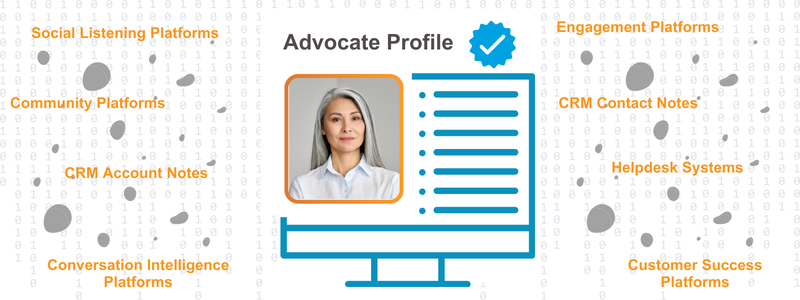
CMA pros are always looking for deeper insights that lead to the best matches, and optimize advocate impact on sales and marketing activities. With AI advancing rapidly, there’s growing enthusiasm about leveraging unstructured data—like Gong conversation transcripts, free-form text notes, and emails—to get the most relevant advocates, and uncover customer advocate candidates.
At first glance, this seems like a potential goldmine. More data should mean more insights, right? Not necessarily. While unstructured data can contain valuable nuggets of information, it’s unreliable as a primary source for identifying who is actually willing to engage in customer advocacy activities—like taking sales reference calls, speaking at events, or participating in media interviews.
It’s usefulness in surfacing positive sentiment customer quotes possibly leading to richer, more compelling content (slides, website quotes, case studies), that’s a more realistic, near-term use case. This is a true gamechanger for time-challenged program managers!
I’ll refer to the collection of related advocate information as an advocate profile. In ReferenceEdge, it is designed to provide a structured, up-to-date, well-populated repository of advocate insights. And we’ve built a variety of features in ReferenceEdge addressing recruiting and data updating to ensure it stays that way. Done right, this profile data may very well be the most accurate data source in your company outside of financials. Advocate profiles are (or should be) the gold standard of customer advocate intelligence, and include, at a minimum:
Because this data is structured and quality controlled, it enables precise, fast searches—ensuring that sales and marketing teams can quickly find pre-qualified, highly matched advocates with full confidence. Trustworthy information is the name of the game. Without it users return to their highly inefficient, unreliable advocate “hunting” behavior using Slack, Teams or email, and user adoption of the program and enabling systems is undermined. Their customer advocate need becomes everyone’s problem. because entire sales and CS teams have to evaluate scatter shot messages asking for help
Unstructured data, by contrast, is anything that doesn’t fit neatly into an organized database—sales call transcripts, rep notes, customer emails, and Slack conversations. AI-powered tools can analyze these data sources for sentiment, intent, and context, but they lack the certainty and structure required for confident advocacy identification—although results are confidently returned.
The result of each of these promising insights is a separate, just-in-time recruiting effort. If the goal is efficiency, then adding the recruiting step to every request fulfillment motion is counterproductive. It is the opposite of building and maintaining a verified database of ready-to-go advocates.
Does this mean unstructured data is useless? Not at all. It might highlight advocate candidates (i.e., advocates-in-the-making), identify trending sentiment shifts, and surface opportunities for further validation.
But it’s purely a secondary layer of insight—not a replacement for structured advocate profile data. Think of it like this:
The excitement and novelty of AI has naturally led to atmospheric expectations about leveraging unstructured data within customer advocacy programs. While AI can surface insights from call transcripts, notes, and emails, advocate decisions require certainty—especially when engaging your best customers. Over-relying on unstructured data puts sales and marketing at risk by leading to mismatched advocacy requests, busy work, eroding trust in AI tools, and driving disengagement among customers who feel misaligned with outreach. The result? Sales teams lose confidence, AI adoption stalls, and customers start tuning out. AI will improve over time, but nothing—whether used by AI or humans—beats the power of reliable, structured data. Never stop tending to your advocate profile data and your AI dreams just may come true.
Contact us today to learn how we can help.
